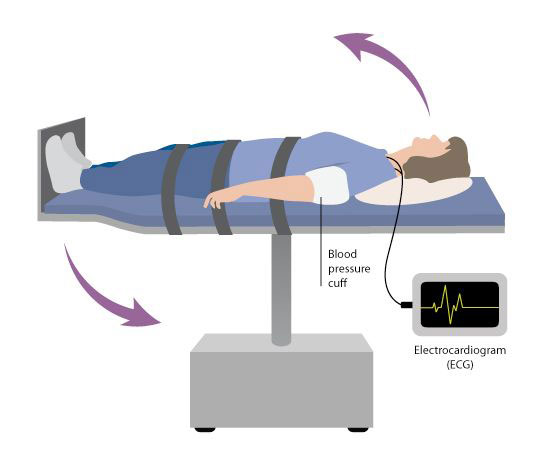What is a Tilt Table Test Used For?
A tilt table test is used to evaluate the cause of unexplained dizziness, lightheadedness, or fainting (syncope). Even if you have fainted only once, another episode could put you at high risk of injury due to your work environment, medical history, age or other factors. This test may be recommended by your doctor to try to trigger your signs and symptoms.

Before your Tilt Table Test
Try to arrive 15 minutes early for your appointment. This will allow time to check in. For best results, prepare for the test as directed. Keep in mind:
- When you schedule the test, be sure to mention all the medications you take. Ask if you should stop taking any of them the day of the test.
- A few days ahead, arrange for a ride home after the test.
- After the midnight before the test, don’t eat or drink anything.
- On the day of the test, dress for ease and comfort. Wear a two-piece outfit, top and bottoms. You will need to undress from the waist up and put on a short hospital gown.
You will be monitored by your healthcare team through the entire test.
Before Your Tilt Table Test
Try to arrive 15 minutes early for your appointment. This will allow time to check in. For best results, prepare for the test as directed. Keep in mind:
- When you schedule the test, be sure to mention all the medications you take. Ask if you should stop taking any of them the day of the test.
- A few days ahead, arrange for a ride home after the test.
- After the midnight before the test, don’t eat or drink anything.
- On the day of the test, dress for ease and comfort. Wear a two-piece outfit, top and bottoms. You will need to undress from the waist up and put on a short hospital gown.
You will be monitored by your healthcare team through the entire test.
During Your Tilt Table Test
Tilt table testing takes about 60 minutes. The testing room is kept quiet and dimly lit. During the test:
- Small pads (electrodes) are put on your chest to monitor your heartbeat.
- A blood pressure cuff is put on your arm.
- An IV (intravenous) line may be placed in your other arm. The IV line delivers fluids.
- You’ll be asked to lie flat on the table. Your upper body and thighs will be held in place with straps.
- The table tilts until you are almost standing upright.
- You’ll remain upright for up to 60 minutes. In most cases, the test is over in 30–45 minutes.
Occasionally, people are given certain medications and retested. These medications may make you feel shaky.
Report Any Symptoms You Have During the Test
- Let the doctor or technician know if you notice:
- Overall weakness
- Nausea
- Dimmed vision
- Sweating or lightheadedness
- A rapid heartbeat
- Any other symptoms
After Your Table Tilt Test
Any medications used during the test should leave your system within 15 minutes. If you were told to skip daily medications before the test, ask if you should start taking them again. You’re likely to be sent home right away. It’s a good idea to have a friend or family member drive. If you fainted during the test, you may want to rest for a few hours once you’re home.
